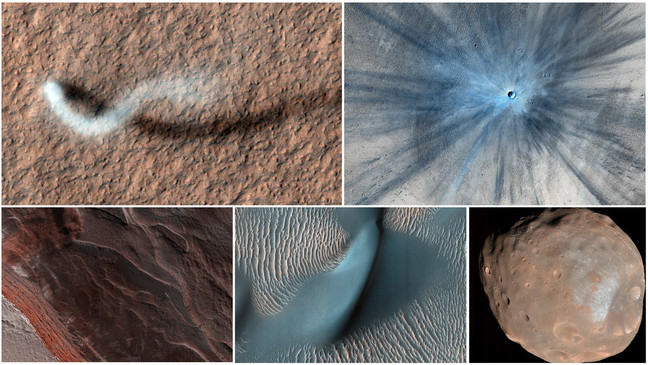NASA is taking weather observations on Mars, and you can follow along
WASHINGTON (WJLA) — Whether it's searching for evidence of life, or dreaming about a future colony, Mars has always caught the imagination of the public.
As NASA's list of missions continues to grow, more of what was left to imagination becomes known. We are observing and learning more about the red planet now than ever. And that includes the weather!
{sd-embed class="sd-embedded-media" data-embed-file="%3Cdiv%3E%3Ciframe%20src=%22https://mars.nasa.gov/layout/embed/image/insightweather/%22%20width=%22800%22%20height=%22530%22%20%20scrolling=%22no%22%20frameborder=%220%22%3E%3C/iframe%3E%3C/div%3E" data-embed-type="code" contenteditable="false"}{/sd-embed}
Mars InSight was launched on May 5th, 2018, and landed on November 26th of the same year.InSight's mission is to study the interior of the planet, and track its "vital signs:" its pulse (seismology), temperature (heat flow), and reflexes (precision tracking).
{sd-embed class="sd-embedded-media" data-alt="Mars%20Collage.jpg" data-caption="Five%20images%20taken%20by%20the%20HiRISE%20camera%20aboard%20NASA's%20Mars%20Reconnaissance%20Orbiter,%20which%20launched%2015%20years%20ago,%20on%20Aug.%2012,%202005%20(CreditNASA/JPL-Caltech/University%20of%20Arizona)" data-duration="" data-externalid="cbd7daa4-50fe-405f-a416-57086685e7a2" data-mediatype="image" data-renditions="%7B%22large16x9%22:%7B%22blurSigma%22:-1,%22height%22:900,%22label%22:%22large16x9%22,%22scaleWidth%22:986,%22url%22:%22/resources/media/cbd7daa4-50fe-405f-a416-57086685e7a2-large16x9_MarsCollage.jpg?1597775197091%22,%22width%22:1600,%22x%22:0,%22y%22:0,%22uuid%22:null,%22id%22:%22aed366ce-56d3-42d1-9ee4-510bf12edf0f%22,%22preciseWidth%22:null,%22preciseHeight%22:null,%22name%22:%22large16x9Url%22,%22rendition%22:%22large16x9%22,%22labelOrConvertedName%22:%22large16x9%22%7D,%22jumbo16x9%22:%7B%22blurSigma%22:-1,%22height%22:900,%22label%22:%22jumbo16x9%22,%22scaleWidth%22:1320,%22url%22:%22/resources/media/cbd7daa4-50fe-405f-a416-57086685e7a2-jumbo16x9_MarsCollage.jpg?1597775197156%22,%22width%22:1600,%22x%22:0,%22y%22:0,%22uuid%22:null,%22id%22:%22a20fdb15-a027-42fa-8cd6-11cbe6408bdf%22,%22preciseWidth%22:null,%22preciseHeight%22:null,%22name%22:%22jumbo16x9Url%22,%22rendition%22:%22jumbo16x9%22,%22labelOrConvertedName%22:%22jumbo16x9%22%7D,%22small16x9%22:%7B%22blurSigma%22:-1,%22height%22:900,%22label%22:%22small16x9%22,%22scaleWidth%22:160,%22url%22:%22/resources/media/cbd7daa4-50fe-405f-a416-57086685e7a2-small16x9_MarsCollage.jpg?1597775200732%22,%22width%22:1600,%22x%22:0,%22y%22:0,%22uuid%22:null,%22id%22:%2203fd9202-d1d2-4900-9e7a-23a4e30db9c3%22,%22preciseWidth%22:null,%22preciseHeight%22:null,%22name%22:%22small16x9Url%22,%22rendition%22:%22small16x9%22,%22labelOrConvertedName%22:%22small16x9%22%7D,%22full16x9%22:%7B%22blurSigma%22:-1,%22height%22:900,%22label%22:%22full16x9%22,%22scaleWidth%22:1600,%22url%22:%22/resources/media/cbd7daa4-50fe-405f-a416-57086685e7a2-full16x9_MarsCollage.jpg?1597775197195%22,%22width%22:1600,%22x%22:0,%22y%22:0,%22uuid%22:null,%22id%22:%227888ad6c-0921-4540-9730-053de80b2a6e%22,%22preciseWidth%22:null,%22preciseHeight%22:null,%22name%22:%22full16x9Url%22,%22rendition%22:%22full16x9%22,%22labelOrConvertedName%22:%22full16x9%22%7D,%22medium16x9%22:%7B%22blurSigma%22:-1,%22height%22:900,%22label%22:%22medium16x9%22,%22scaleWidth%22:648,%22url%22:%22/resources/media/cbd7daa4-50fe-405f-a416-57086685e7a2-medium16x9_MarsCollage.jpg?1597775196981%22,%22width%22:1600,%22x%22:0,%22y%22:0,%22uuid%22:null,%22id%22:%2217f47bc0-ec87-42f5-af05-1bd81db79ffb%22,%22preciseWidth%22:null,%22preciseHeight%22:null,%22name%22:%22medium16x9Url%22,%22rendition%22:%22medium16x9%22,%22labelOrConvertedName%22:%22medium16x9%22%7D%7D" data-thumburl="/resources/media/cbd7daa4-50fe-405f-a416-57086685e7a2-medium16x9_MarsCollage.jpg?1597775196981" data-title="Mars%20Collage.jpg" data-url="" data-embed-file="%0A%20%20%20%20%3Cdiv%20class=%22sda-ImageEmbed%22%3E%0A%20%20%20%20%20%20%20%20%3Cimg%20src=%22/resources/media/cbd7daa4-50fe-405f-a416-57086685e7a2-medium16x9_MarsCollage.jpg?1597775196981%22%20alt=%22%22%20/%3E%0A%20%20%20%20%20%20%20%20%3Cdiv%20class=%22sda-ImageEmbed-caption%22%3EFive%20images%20taken%20by%20the%20HiRISE%20camera%20aboard%20NASA's%20Mars%20Reconnaissance%20Orbiter,%20which%20launched%2015%20years%20ago,%20on%20Aug.%2012,%202005%20(CreditNASA/JPL-Caltech/University%20of%20Arizona)%3C/div%3E%0A%20%20%20%20%3C/div%3E%0A" data-embed-type="image" contenteditable="false"}{/sd-embed}
It also takes daily weather measurements from its location at Elysium Planitia, a plain near Mars' equator. Specifically, it measures temperature, wind and pressure - similar to the observations we collect here on earth.
Mars has a thin atmosphere made up primarily of carbon dioxide. There is enough water vapor to form thin, wispy clouds, but no precipitation ever falls, so InSight has no need to measure rainfall.
{sd-embed class="sd-embedded-media" data-alt="InSight.jpg" data-caption="This%20artist's%20concept%20depicts%20NASA's%20InSight%20lander%20after%20it%20has%20deployed%20its%20instruments%20on%20the%20Martian%20surface.%20(Credit%7B%7DNASA/JPL-Caltech)" data-duration="" data-externalid="986f6dbc-effb-4295-91f3-aa63b6aaf21f" data-mediatype="image" data-renditions="%7B%22large16x9%22:%7B%22blurSigma%22:-1,%22height%22:787,%22label%22:%22large16x9%22,%22scaleWidth%22:986,%22url%22:%22/resources/media/986f6dbc-effb-4295-91f3-aa63b6aaf21f-large16x9_InSight.jpg?1597771329183%22,%22width%22:1400,%22x%22:0,%22y%22:1,%22uuid%22:null,%22id%22:%2234e2e4fd-97e9-441c-8964-e7983a4833a5%22,%22preciseWidth%22:null,%22preciseHeight%22:null,%22name%22:%22large16x9Url%22,%22rendition%22:%22large16x9%22,%22labelOrConvertedName%22:%22large16x9%22%7D,%22jumbo16x9%22:%7B%22blurSigma%22:-1,%22height%22:787,%22label%22:%22jumbo16x9%22,%22scaleWidth%22:1320,%22url%22:%22/resources/media/986f6dbc-effb-4295-91f3-aa63b6aaf21f-jumbo16x9_InSight.jpg?1597771329236%22,%22width%22:1400,%22x%22:0,%22y%22:1,%22uuid%22:null,%22id%22:%22853582a9-824b-4d10-a87a-dbb52ebc33db%22,%22preciseWidth%22:null,%22preciseHeight%22:null,%22name%22:%22jumbo16x9Url%22,%22rendition%22:%22jumbo16x9%22,%22labelOrConvertedName%22:%22jumbo16x9%22%7D,%22small16x9%22:%7B%22blurSigma%22:-1,%22height%22:787,%22label%22:%22small16x9%22,%22scaleWidth%22:160,%22url%22:%22/resources/media/986f6dbc-effb-4295-91f3-aa63b6aaf21f-small16x9_InSight.jpg?1597771332670%22,%22width%22:1400,%22x%22:0,%22y%22:1,%22uuid%22:null,%22id%22:%220fb101d3-1ef1-427f-a152-fbcbbcc2a4f3%22,%22preciseWidth%22:null,%22preciseHeight%22:null,%22name%22:%22small16x9Url%22,%22rendition%22:%22small16x9%22,%22labelOrConvertedName%22:%22small16x9%22%7D,%22full16x9%22:%7B%22blurSigma%22:-1,%22height%22:787,%22label%22:%22full16x9%22,%22scaleWidth%22:1400,%22url%22:%22/resources/media/986f6dbc-effb-4295-91f3-aa63b6aaf21f-full16x9_InSight.jpg?1597771329181%22,%22width%22:1400,%22x%22:0,%22y%22:1,%22uuid%22:null,%22id%22:%22dae2c6aa-9c1e-45a9-89aa-432e8ec9edb7%22,%22preciseWidth%22:null,%22preciseHeight%22:null,%22name%22:%22full16x9Url%22,%22rendition%22:%22full16x9%22,%22labelOrConvertedName%22:%22full16x9%22%7D,%22medium16x9%22:%7B%22blurSigma%22:-1,%22height%22:787,%22label%22:%22medium16x9%22,%22scaleWidth%22:648,%22url%22:%22/resources/media/986f6dbc-effb-4295-91f3-aa63b6aaf21f-medium16x9_InSight.jpg?1597771329138%22,%22width%22:1400,%22x%22:0,%22y%22:1,%22uuid%22:null,%22id%22:%22fda49bcf-8d43-468d-8a54-6bfb59a0133e%22,%22preciseWidth%22:null,%22preciseHeight%22:null,%22name%22:%22medium16x9Url%22,%22rendition%22:%22medium16x9%22,%22labelOrConvertedName%22:%22medium16x9%22%7D%7D" data-thumburl="/resources/media/986f6dbc-effb-4295-91f3-aa63b6aaf21f-medium16x9_InSight.jpg?1597771329138" data-title="InSight.jpg" data-url="" data-embed-file="%0A%20%20%20%20%3Cdiv%20class=%22sda-ImageEmbed%22%3E%0A%20%20%20%20%20%20%20%20%3Cimg%20src=%22/resources/media/986f6dbc-effb-4295-91f3-aa63b6aaf21f-medium16x9_InSight.jpg?1597771329138%22%20alt=%22%22%20/%3E%0A%20%20%20%20%20%20%20%20%3Cdiv%20class=%22sda-ImageEmbed-caption%22%3EThis%20artist's%20concept%20depicts%20NASA's%20InSight%20lander%20after%20it%20has%20deployed%20its%20instruments%20on%20the%20Martian%20surface.%20(CreditNASA/JPL-Caltech)%3C/div%3E%0A%20%20%20%20%3C/div%3E%0A" data-embed-type="image" contenteditable="false" }<="" sd-embed="">{/sd-embed}
You can see Insight's daily weather reports here.
Over the past few days, the station has recorded "high" temperatures around zero degrees Fahrenheit, and low temperatures falling to more than 80 degrees below zero. Max wind speeds have peaked at over 50mph.
Out of curiosity, I plugged the numbers for the coldest and windiest combo into a wind chill calculator. -137.4F with 53.4 mph winds on August 9th (Sol 606) equals a wind chill of -225F. Yikes!
{sd-embed class="sd-embedded-media" data-alt="Mars%20Seasons.JPG" data-caption="Insight%20Observations%20through%20the%20Seasons%20(https://mars.nasa.gov/insight/weather/)" data-duration="" data-externalid="ee229f59-c617-4fe4-bbe0-81b32142f0b4" data-mediatype="image" data-renditions="%7B%22large16x9%22:%7B%22blurSigma%22:-1,%22height%22:818,%22label%22:%22large16x9%22,%22scaleWidth%22:986,%22url%22:%22/resources/media/ee229f59-c617-4fe4-bbe0-81b32142f0b4-large16x9_MarsSeasons.JPG?1597772025795%22,%22width%22:1454,%22x%22:127,%22y%22:0,%22uuid%22:null,%22id%22:%22d5c4a2da-b3d2-44c5-bad0-688fddabdddc%22,%22preciseWidth%22:null,%22preciseHeight%22:null,%22name%22:%22large16x9Url%22,%22rendition%22:%22large16x9%22,%22labelOrConvertedName%22:%22large16x9%22%7D,%22jumbo16x9%22:%7B%22blurSigma%22:-1,%22height%22:818,%22label%22:%22jumbo16x9%22,%22scaleWidth%22:1320,%22url%22:%22/resources/media/ee229f59-c617-4fe4-bbe0-81b32142f0b4-jumbo16x9_MarsSeasons.JPG?1597772025916%22,%22width%22:1454,%22x%22:127,%22y%22:0,%22uuid%22:null,%22id%22:%2240c20742-64fe-4efa-8ed4-edd511826ed0%22,%22preciseWidth%22:null,%22preciseHeight%22:null,%22name%22:%22jumbo16x9Url%22,%22rendition%22:%22jumbo16x9%22,%22labelOrConvertedName%22:%22jumbo16x9%22%7D,%22small16x9%22:%7B%22blurSigma%22:-1,%22height%22:818,%22label%22:%22small16x9%22,%22scaleWidth%22:160,%22url%22:%22/resources/media/ee229f59-c617-4fe4-bbe0-81b32142f0b4-small16x9_MarsSeasons.JPG?1597772029118%22,%22width%22:1454,%22x%22:127,%22y%22:0,%22uuid%22:null,%22id%22:%22b8db9f35-0f2a-4879-a1ea-fb15907b6cce%22,%22preciseWidth%22:null,%22preciseHeight%22:null,%22name%22:%22small16x9Url%22,%22rendition%22:%22small16x9%22,%22labelOrConvertedName%22:%22small16x9%22%7D,%22full16x9%22:%7B%22blurSigma%22:-1,%22height%22:818,%22label%22:%22full16x9%22,%22scaleWidth%22:1454,%22url%22:%22/resources/media/ee229f59-c617-4fe4-bbe0-81b32142f0b4-full16x9_MarsSeasons.JPG?1597772026128%22,%22width%22:1454,%22x%22:127,%22y%22:0,%22uuid%22:null,%22id%22:%220fd386ac-2232-4914-aae4-0d360a93b4a3%22,%22preciseWidth%22:null,%22preciseHeight%22:null,%22name%22:%22full16x9Url%22,%22rendition%22:%22full16x9%22,%22labelOrConvertedName%22:%22full16x9%22%7D,%22medium16x9%22:%7B%22blurSigma%22:-1,%22height%22:818,%22label%22:%22medium16x9%22,%22scaleWidth%22:648,%22url%22:%22/resources/media/ee229f59-c617-4fe4-bbe0-81b32142f0b4-medium16x9_MarsSeasons.JPG?1597772025793%22,%22width%22:1454,%22x%22:127,%22y%22:0,%22uuid%22:null,%22id%22:%22d11f49a9-bf9c-4843-9e28-90819cad91c1%22,%22preciseWidth%22:null,%22preciseHeight%22:null,%22name%22:%22medium16x9Url%22,%22rendition%22:%22medium16x9%22,%22labelOrConvertedName%22:%22medium16x9%22%7D%7D" data-thumburl="/resources/media/ee229f59-c617-4fe4-bbe0-81b32142f0b4-medium16x9_MarsSeasons.JPG?1597772025793" data-title="Mars%20Seasons.JPG" data-url="" data-embed-file="%0A%20%20%20%20%3Cdiv%20class=%22sda-ImageEmbed%22%3E%0A%20%20%20%20%20%20%20%20%3Cimg%20src=%22/resources/media/ee229f59-c617-4fe4-bbe0-81b32142f0b4-medium16x9_MarsSeasons.JPG?1597772025793%22%20alt=%22%22%20/%3E%0A%20%20%20%20%20%20%20%20%3Cdiv%20class=%22sda-ImageEmbed-caption%22%3EInsight%20Observations%20through%20the%20Seasons%20(https://mars.nasa.gov/insight/weather/)%3C/div%3E%0A%20%20%20%20%3C/div%3E%0A" data-embed-type="image" contenteditable="false"}{/sd-embed}
InSight temperature observations (top line in the graph above) look fairly steady throughout the year. But the National Weather Service says summertime temperatures near the Mars equator can reach 70F. The average annual temperature on the planet is about -81F.
{sd-embed class="sd-embedded-media" data-alt="Mars%20Pole%20Wide.JPG" data-caption="This%20is%20an%20image%20of%20the%20ultraviolet%20%E2%80%9Cnightglow%E2%80%9D%20in%20the%20Martian%20atmosphere%20over%20the%20south%20pole%20(Credit%20NASA/MAVEN/Goddard%20Space%20Flight%20Center/CU/LASP)" data-duration="" data-externalid="9dde680c-32a7-47f7-a0fe-8ea98ab975ad" data-mediatype="image" data-renditions="%7B%22jumbo16x9%22:%7B%22blurSigma%22:-1,%22height%22:801,%22label%22:%22jumbo16x9%22,%22scaleWidth%22:1320,%22url%22:%22/resources/media/9dde680c-32a7-47f7-a0fe-8ea98ab975ad-jumbo16x9_MarsPoleWide.JPG?1597775053155%22,%22width%22:1425,%22x%22:0,%22y%22:26,%22uuid%22:null,%22id%22:%22425af666-007c-4154-aac0-36cdc3570835%22,%22preciseWidth%22:null,%22preciseHeight%22:null,%22name%22:%22jumbo16x9Url%22,%22rendition%22:%22jumbo16x9%22,%22labelOrConvertedName%22:%22jumbo16x9%22%7D,%22large16x9%22:%7B%22blurSigma%22:-1,%22height%22:801,%22label%22:%22large16x9%22,%22scaleWidth%22:986,%22url%22:%22/resources/media/9dde680c-32a7-47f7-a0fe-8ea98ab975ad-large16x9_MarsPoleWide.JPG?1597775053241%22,%22width%22:1425,%22x%22:0,%22y%22:26,%22uuid%22:null,%22id%22:%22df270ba2-cd22-4cd6-a4f1-3bbfda1e4b61%22,%22preciseWidth%22:null,%22preciseHeight%22:null,%22name%22:%22large16x9Url%22,%22rendition%22:%22large16x9%22,%22labelOrConvertedName%22:%22large16x9%22%7D,%22small16x9%22:%7B%22blurSigma%22:-1,%22height%22:801,%22label%22:%22small16x9%22,%22scaleWidth%22:160,%22url%22:%22/resources/media/9dde680c-32a7-47f7-a0fe-8ea98ab975ad-small16x9_MarsPoleWide.JPG?1597775056104%22,%22width%22:1425,%22x%22:0,%22y%22:26,%22uuid%22:null,%22id%22:%22ee2675dd-4645-4ca5-a0fd-de2cf2fc01f3%22,%22preciseWidth%22:null,%22preciseHeight%22:null,%22name%22:%22small16x9Url%22,%22rendition%22:%22small16x9%22,%22labelOrConvertedName%22:%22small16x9%22%7D,%22full16x9%22:%7B%22blurSigma%22:-1,%22height%22:801,%22label%22:%22full16x9%22,%22scaleWidth%22:1425,%22url%22:%22/resources/media/9dde680c-32a7-47f7-a0fe-8ea98ab975ad-full16x9_MarsPoleWide.JPG?1597775053173%22,%22width%22:1425,%22x%22:0,%22y%22:26,%22uuid%22:null,%22id%22:%22ea81e620-0842-4b6d-8c85-41772e3b02fc%22,%22preciseWidth%22:null,%22preciseHeight%22:null,%22name%22:%22full16x9Url%22,%22rendition%22:%22full16x9%22,%22labelOrConvertedName%22:%22full16x9%22%7D,%22medium16x9%22:%7B%22blurSigma%22:-1,%22height%22:801,%22label%22:%22medium16x9%22,%22scaleWidth%22:648,%22url%22:%22/resources/media/9dde680c-32a7-47f7-a0fe-8ea98ab975ad-medium16x9_MarsPoleWide.JPG?1597775053150%22,%22width%22:1425,%22x%22:0,%22y%22:26,%22uuid%22:null,%22id%22:%224f5600da-7c3b-49ed-b111-3073a18ca72c%22,%22preciseWidth%22:null,%22preciseHeight%22:null,%22name%22:%22medium16x9Url%22,%22rendition%22:%22medium16x9%22,%22labelOrConvertedName%22:%22medium16x9%22%7D%7D" data-thumburl="/resources/media/9dde680c-32a7-47f7-a0fe-8ea98ab975ad-medium16x9_MarsPoleWide.JPG?1597775053150" data-title="Mars%20Pole%20Wide.JPG" data-url="" data-embed-file="%0A%20%20%20%20%3Cdiv%20class=%22sda-ImageEmbed%22%3E%0A%20%20%20%20%20%20%20%20%3Cimg%20src=%22/resources/media/9dde680c-32a7-47f7-a0fe-8ea98ab975ad-medium16x9_MarsPoleWide.JPG?1597775053150%22%20alt=%22%22%20/%3E%0A%20%20%20%20%20%20%20%20%3Cdiv%20class=%22sda-ImageEmbed-caption%22%3EThis%20is%20an%20image%20of%20the%20ultraviolet%20%E2%80%9Cnightglow%E2%80%9D%20in%20the%20Martian%20atmosphere%20over%20the%20south%20pole%20(Credit%20NASA/MAVEN/Goddard%20Space%20Flight%20Center/CU/LASP)%3C/div%3E%0A%20%20%20%20%3C/div%3E%0A" data-embed-type="image" contenteditable="false"}{/sd-embed}
Mars does have seasons. Its tilt is around 25 degrees, not too far off from our own 23.5 degree tilt.While a day is 24.6 hours (similar to a day on Earth), a year is 687 days long, almost double the length of our year. This means that the seasons also last longer. Evidence of the changes can be seen by white caps of H20 and CO2 ice growing and receding at the poles.
{sd-embed class="sd-embedded-media" data-embed-file="1257747075967512576" data-embed-type="twitter" contenteditable="false"}{/sd-embed}
If it is a question of human survival in Mars' weather conditions, the results aren't favorable. The fact that Mars' atmospheric pressure is just 1-2% of that on earth doesn't help either. But it certainly is fun watch from afar!




